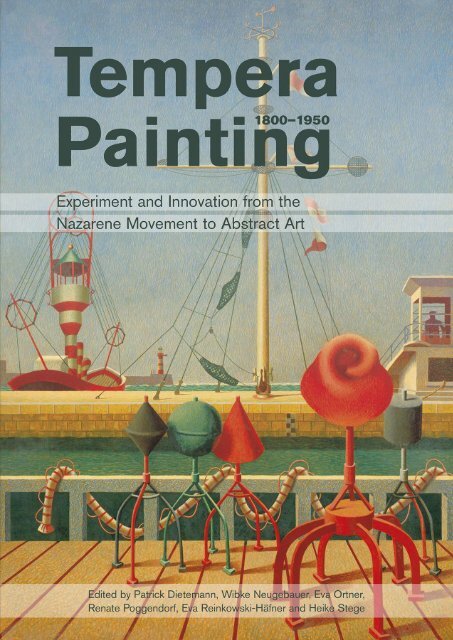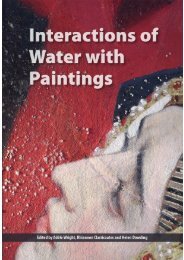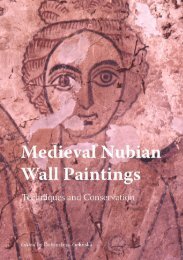Tempera Painting 1800-1950
The papers and posters in this volume were presented at the international conference Tempera Painting between 1800 and 1950: Experiments and Innovations from the Nazarene Movement to Abstract Art held at the Doerner Institut, in cooperation with the Academy of Fine Arts, Munich, the Technical University Munich (Chair of Conservation-Restoration, Art Technology and Conservation Science) and museum partners Villa Stuck and the Lenbachhaus. These texts explore the revival of tempera painting between 1800 and 1950 from the perspectives of art history, technical art history, conservation and scientific analysis. General papers provide an overview on topics such as the historical background of tempera painting, its terminologies,commercial production and the reconstruction of historical recipes, fundamentals of rheology, binding medium analyses and their interpretation. Particular papers focus on the work of Christina Herringham, Frances Hodgkins, Paul Klee, Hermann Prell, John Roddam Spencer Stanhope, Joseph Southall, Edward Steichen and Ossawa Tanner. The book offers new insights into what artists were trying to achieve, the materials they used and how they prepared and applied them.
The papers and posters in this volume were presented at the international conference Tempera Painting between 1800 and 1950: Experiments and Innovations from the Nazarene Movement to Abstract Art held at the Doerner Institut, in cooperation with the Academy of Fine Arts, Munich, the Technical University Munich (Chair of Conservation-Restoration, Art Technology and Conservation Science) and museum partners Villa Stuck and the Lenbachhaus.
These texts explore the revival of tempera painting between 1800 and 1950 from the perspectives of art history, technical art history, conservation and scientific analysis. General papers provide an overview on topics such as the historical background of tempera painting, its terminologies,commercial production and the reconstruction of historical recipes, fundamentals of rheology, binding medium analyses and their interpretation. Particular papers focus on the work of Christina Herringham, Frances Hodgkins, Paul Klee, Hermann Prell, John Roddam Spencer Stanhope, Joseph Southall, Edward Steichen and Ossawa Tanner. The book offers new insights into what artists were trying to achieve, the materials they used and how they prepared and applied them.
Create successful ePaper yourself
Turn your PDF publications into a flip-book with our unique Google optimized e-Paper software.
KATHRIN KINSEHER<br />
some varnish recipes. A comparison between the<br />
1916 and 1920 editions of Technik der Malerei nebst<br />
kurzgefaßter Farbenlehre and the 1928 edition revised<br />
by Max Doerner after Wirth’s death, reveals several<br />
changes in the tempera recipes. For example, Doerner<br />
removed glycerine, vinegar and honey previously used<br />
by Wirth and recommends egg and casein instead of<br />
gum arabic (see Table 2).<br />
Figure 3 Ernst Berger, study painting in the technique<br />
of Cennino Cennini after Sandro Botticelli, Primavera<br />
(detail), Uffizi Gallery, Florence, Deutsches Museum<br />
inv. No. 11564 (Berger 1897: 114). (Photo: Bayerische<br />
Staatsgemäldesammlungen © Deutsches Museum.)<br />
Ernst Täuber<br />
Contributions in Technische Mitteilungen für Malerei<br />
and Münchner kunsttechnische Blätter (Munich Art<br />
Technology Newssheets) by Ernst Täuber (1861–1944)<br />
evidence a deep research interest in oils, resins, wax<br />
and pigments with less emphasis on tempera. After<br />
retiring in 1934 Täuber published the article ‘Kleiner<br />
Ratgeber in künstlerischen Materialfragen’ (‘Concise<br />
manual of questions of artists’ materials’) (Täuber<br />
1934/1935; 1935) as a condensed outcome of his<br />
teaching, which also contained a very short passage on<br />
tempera binders. Täuber provided recipes for an egglinseed-oil<br />
and a casein-linseed-oil emulsion (Täuber<br />
1934/35: 51) (see Table 2). He considered it acceptable<br />
to add resin solutions in small quantities and advised<br />
that the addition of wax emulsions might have some<br />
positive effect but additions such as glycerine and<br />
vinegar were rejected categorically. To avoid colour<br />
change induced by varnishing, the application of a<br />
solution of casein or zapon was recommended before<br />
applying a dammar matt varnish (Dammar-Mattlack).<br />
Whereas in Berlin Täuber and Wirth seemed to have<br />
cultivated a peaceful and harmonious coexistence,<br />
the situation in Munich was affected by rivalries and<br />
competition.<br />
Munich<br />
Figure 4 Alexander Eibner (first row in the middle) at<br />
the Versuchsanstalt- und Auskunftsstelle für Maltechnik<br />
(Research Institute and Information Centre for <strong>Painting</strong><br />
Technology) at the Technical University of Munich. The<br />
person on his left is probably presenting Eibner’s book<br />
Malmaterialienkunde als Grundlage der Maltechnik. (Photo:<br />
estate of Prof. Anton Dietl, made available by Ingo Rogner,<br />
Akademische Chemiker Verbindung.)<br />
Ernst Berger<br />
Ernst Berger (1857–1919) experienced this atmosphere<br />
of intrigue when his lectureship at the Academy<br />
of Fine Arts (Akademie der Bildenden Künste) came<br />
to an end in 1904 after two winter semesters. Berger’s<br />
research into the history of painting techniques and<br />
his extensive teaching exerted a remarkable influence<br />
on the reception of tempera painting (Kinseher<br />
2016). Berger supplied a series of tempera recipes<br />
(see Table 2), 9 even including some from standard<br />
works on decorative painting (Berger 1897: 258–60),<br />
38
COLOUR AND FORM IN HIGHEST PERFECTION: TEACHING TEMPERA IN THE EARLY 20TH CENTURY<br />
Figure 5 Max Doerner, list of lectures at the Academy of Fine Arts, Munich, during the winter<br />
semester 1913–14. (Photo: Kathrin Kinseher © Akademie der Bildenden Künste München.)<br />
and described some of the commercially available<br />
tempera paints that already included paints mixable<br />
both with water and oil. 10 His study paintings on<br />
technique served as teaching aids as well as exhibits<br />
in the Deutsches Museum’s painting room (Kinseher<br />
2018) (Fig. 3).<br />
Alexander Eibner<br />
Starting from the winter semester 1905, before<br />
regular technical lessons were established at the<br />
Academy of Fine Arts, painting students were<br />
required to attend the lectures by the chemist<br />
Alexander Eibner (1862–1935) at the Technical<br />
University of Munich (Technische Hochschule<br />
München). The programme and dates of Eibner’s<br />
lectures were announced in Technische Mitteilungen<br />
für Malerei (Anon. 1905, 1906). Different types of<br />
tempera were explained in lecture 9 (of a course<br />
of 12) among a variety of subjects that included<br />
coal tar pigments as well as inorganic and organic<br />
39
TERESA PERUSINI, GIUSEPPINA PERUSINI, FRANCESCA C. IZZO AND GIOVANNI SOCCOL<br />
Figure 5 GC-MS analysis of Laurenti’s tempera.<br />
Figure 6 Cesare Laurenti, The Shadow (detail), tempera on wood, 1907, Museo Ca’ Pesaro, Venice.<br />
102
TEMPERA PAINTING IN VENETO AT THE BEGINNING OF THE 20TH CENTURY<br />
Figure 7 Micro-FTIR and GC-MS analysis of Cadorin’s tempera.<br />
years from the age of 15, Cadorin attended the school<br />
run by Laurenti from whom he learned the love of<br />
tempera (Dal Canton 2007: 32–9). In his technical<br />
notes, Laurenti suggested the use of skin glue-based<br />
tempera as a medium for clear colour and a mixture<br />
of gum arabic and flax seed mucilage for dark colours<br />
(Laurenti 1990: 81; Rinaldi et al. 2017) but until now<br />
his tempera medium has not been analysed. In this<br />
study, for the first time, we have scientific evidence<br />
of the recipes used by Laurenti for two important<br />
paintings in the International Gallery of Modern Art<br />
Ca’Pesaro in Venice, New Flowering (1897) and The<br />
Shadow (1907), both dating to the period in which<br />
the artist carried out most of his experiments with<br />
tempera recipes. Analyses using μ-FTIR and GC-MS<br />
performed on microsamples taken from the selected<br />
paintings confirmed Laurenti’s descriptions of his<br />
recipes: in particular, animal glue was found as the<br />
binding medium for white and clear brushstrokes,<br />
while the typical polysaccharidic compounds present<br />
in the gum arabic and flaxseed mucilage<br />
were detected for dark and brown colours (Fig. 5).<br />
Furthermore, Soccol’s reconstruction tests showed<br />
that the latter recipe is perfect for dark pigments<br />
especially in thin layers as can be observed in The<br />
Shadow (Fig. 6).<br />
With reference to Cadorin’s tempera paints, it<br />
is known that he mainly used an emulsion tempera<br />
containing egg, glue and linseed oil (Fig. 7)<br />
for easel paintings and a casein-based tempera on<br />
walls. Unlike Maimeri or Ferrario, neither Cadorin<br />
nor Favai turned from self-made paints to industrial<br />
tempera even in the 1940s and 50s when inexpensive<br />
Italian commercial tempera paints were easily available.<br />
From the 1960s Cadorin added Vinavil (a vinyl<br />
polymer produced by Montedison, Italy) to his egg<br />
103
SILKE BEISIEGEL<br />
Figure 5 Fall of the Titans, c.1904, casein paint on canvas (reproduced from Galland 1916, fig. 42].<br />
Neisch & Co. was used for the top paint layer (Prell<br />
1916: 76). 23 Finally he was satisfied at least with the<br />
aesthetic aspects of the execution, noting that ‘it<br />
looks just like fresco, but it is not so firm as all the<br />
rest, and care will be needed when it comes to be<br />
cleaned’ (Prell c.1921, XVI: 55). 24<br />
Fall of the Titans: casein paint on<br />
canvas<br />
Figure 6 Head of Apollo, 1901, tempera on canvas on<br />
cardboard, 88.5 × 64.5 cm, Städtische Galerie Dresden –<br />
Kunstsammlung Museen der Stadt Dresden. (Photo: Franz<br />
Zadnicek.)<br />
away in small flakes when it is painted; very bad!’<br />
(Prell 1916: 76). 22 The drenching of the surface in<br />
casein or a mixture of wax and petrol was unsuccessful.<br />
Recognizing that Gerhardt’s impregnation<br />
lacquer made the painting appear darker he only<br />
used it elsewhere (Prell 1916: 76). The tempera from<br />
The staircase ceiling had originally been divided<br />
into three areas by stucco ornaments. Prell however<br />
intended to create just one picture, and had a<br />
wire-mesh plaster ceiling installed below the existing<br />
ceiling (Prell c.1921, XVI: 1). The painting (80 m 2 )<br />
was executed in tempera paints on canvas and later<br />
adhered to the ceiling (Wünsch 1994: 24) (Fig. 5).<br />
Before carrying out the work, Prell tested a<br />
number of technical variants: ‘Experiment with<br />
Neisch tempera, on the Neisch Helferling ground,<br />
and egg, zinc white, chalk slurry and boiled linseed<br />
oil. The ground is firm; when moistened from<br />
behind it softens, however; it is easy to moisten from<br />
in front. The paint is easy to treat; it remains almost<br />
entirely unchanged’ (Prell 1916: 71). 25 The tempera<br />
study Head of Apollo (Fig. 6) for this painting, dating<br />
from 1901, has survived, with an inscription recording<br />
a similar recipe: ‘Ground does not take easily/<br />
and runs/ Helferling/ chalk-egg/ boiled linseed oil.’ 26<br />
Two further studies are inscribed with technical<br />
details that show how the artist approached the<br />
materials. Titan and Horse (Fig. 7) was painted in<br />
casein paints from Neisch on a Helferling ground<br />
112
‘I EXPLORED EVERY MEANS OF PAINTING BACK THEN, NOTABLY EVERY TEMPERA’: HERMANN PRELL’S RESEARCH ON TEMPERA<br />
Figure 7 Titan and Horse, c.1901, tempera on canvas, 71 × 100 cm, Städtische Galerie Dresden –<br />
Kunstsammlung Museen der Stadt Dresden. (Photo: Franz Zadnicek.)<br />
with casein zinc white and judged by Prell to be<br />
very good: ‘Ground: casein-zinc-white [Helferling]<br />
Neisch/ casein paints Neisch/ very good, even on<br />
dry [canvas]/ only slight brightening/ very firm.’ 27 He<br />
painted Titan’s Head (Fig. 8) in tempera paints made<br />
by Neisch on a moist Helferling ground: ‘Neisch<br />
tempera/ Helferling ground/ wets from behind.’ 28<br />
The execution on ‘casein canvas’ (Prell 1916: 71)<br />
seems to have corresponded with his ‘casein technique<br />
on canvas’ for the Danzig paintings described<br />
above: ‘The large cartoon for the ceiling picture<br />
transferred to the canvas by two pupils, [Richard]<br />
Schlösser and [Paul] Harnisch and the underdrawing<br />
executed’ (Prell c.1921, XVI: 28). 29 In the process,<br />
he carried out the ‘underpainting on the dry [canvas]<br />
with umbra, terra di siena, ultramarine – as needed.<br />
Finally underpainting in local colours without looking<br />
at the effect until no bare canvas was anywhere<br />
to be seen and the picture was there in its entirety’<br />
(Prell XIV, 310). 30 And then Prell began to paint:<br />
I had it moistened from behind piece by piece with<br />
a spray and a large sponge, until it was totally wet.<br />
The wet area looks considerably darker. I mixed<br />
the main hues, as with fresco, in glass jars until<br />
they were stiff, in order to constantly keep the<br />
Figure 8 Titan’s Head, 1903, tempera on canvas, 43.6 × 30.8<br />
cm, Städtische Galerie Dresden – Kunstsammlung Museen<br />
der Stadt Dresden. (Photo: Franz Zadnicek.)<br />
113




